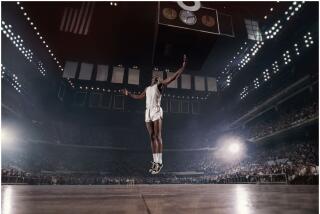A Picture-Perfect Silicon Valley Exit
- Share via
SAN FRANCISCO — To those with a knowledge of computer history, it might make sense that Bill Atkinson’s nature photographs have an elegant simplicity and an economy of design and composition.
After all, those are also the hallmarks of his most famous creation: the user interface of the Apple Macintosh computer.
Atkinson spent nearly 20 years as one of the most influential software designers in computer history, helping to create a look and feel that can still be seen on any computer with a mouse.
But now he is devoting himself full time to what had been a lifelong hobby. And, predictably, he is doing so with a particularly high-tech bent.
Atkinson, 46, might be the most purely digital nature photographer around. His images are processed, manipulated, displayed, printed and sold as bits stored in a computer. The original photographs are still shot on traditional film with conventional cameras, but that too will change, he says, as soon as digital cameras can match the resolution of their analog counterparts.
Just two months ago, Atkinson launched a Web site (https://www.natureimages.com) that serves as his virtual gallery. It is where he “hangs” dozens of his photographs paying tribute to the intimacies of nature: exquisitely colored petals, water-dappled stones and those exhibitionists of the floral world, orchids.
He has taken such pictures since he was a teenager growing up in the hills of Los Gatos, an exclusive community near Silicon Valley. During his computer career, he said, photography was an indispensable release.
“Programming is left-brain intensive and requires intense concentration,” he said. “Photography was very relaxing and nourishing. It was the antidote to my programming stress.”
But the two are not entirely unconnected.
“There is one overlap, which is seeking essence,” Atkinson said. “The key to making an expressive photograph is to eliminate, eliminate, eliminate down to where you’ve got the essence of the subject.
“Something like that happens in software design. You start with a vague notion of what you’re creating. You refine and refine down to the essence. The more times you do a complete rewrite of a piece of software, the more you get down to the essence of it.”
Atkinson took up photography long before programming. During high school, he worked at a Los Gatos photo studio to help pay for his hobby. It wasn’t until he was a graduate student at the University of Washington, when he began tinkering with computers used to analyze neuroscience studies data, that he became intrigued by the device that would change his life.
Jef Raskin, a fellow photographer and computer scientist Atkinson met at UC San Diego, where Raskin taught and Atkinson was an undergraduate, invited him to Silicon Valley in 1977 and work for a start-up company developing a small personal computer. The company was Apple.
Raskin introduced Atkinson to all 30 employees Apple had at the time, including Steve Jobs, the company’s legendary co-founder and its interim chief executive today.
“Jobs put a big sell on me,” Atkinson said. “His argument, which hit home, was that I could influence how things come out, could be ahead of the curve. He said we had a chance to make a difference in the world.”
Atkinson joined Apple and was an important force behind some of the company’s greatest successes, including the point-and-click interface of the Macintosh operating system. He also wrote the original QuickDraw, MacPaint and HyperCard software.
Meanwhile, Atkinson continued taking pictures of nature, giving prints away to co-workers and friends. He said some of his works still hang in the homes of Jobs and John Sculley, who was chief executive of Apple in the 1980s.
In 1990, Atkinson left Apple with two co-workers to found a company called General Magic Inc. The company’s mission was to develop a “personal communicator,” a hand-held device capable of sending pictures and messages to friends, co-workers or family members. Seven years later, Atkinson quit in frustration.
“The personal communicator didn’t happen and wasn’t going to happen,” he said. “That’s what disenchanted me. After 20 years of programming, I was also pretty burned out.”
By then, Atkinson was a multimillionaire, largely because of the Apple stock he owned. Photography was something he could afford to do full time.
These days, he travels frequently to his favorite photographic locales, including New England, the Olympic Peninsula in Washington and the Smoky Mountains in Tennessee. But much of the work is done from his Portola Valley home.
There, he scans his photographs, turning them from etchings on film into digital images he can manipulate using Adobe Photoshop software on a Genesis MP 800 computer. (It’s a Macintosh clone with four 200MHz CPUs, 1.5 gigabytes of random access memory and a 70-gigabyte hard drive.)
Traditional photography is often degenerative, with each step of the printing process meaning the incremental sacrifice of detail and color. But digital techniques extract every detail recorded on the film, he said, and render colors far more faithfully.
At his home studio last week, Atkinson compared identical prints of fallen leaves--one produced digitally and one using traditional optical equipment. The difference was striking. The old-fashioned print seemed to have a brown haze over it, compared with the vibrant and varied colors of the digital print.
“This is so much closer to how it looked in real life,” said Atkinson, who has helped a number of prominent Bay Area photographers learn how to use the new equipment. “It’s much more significant than the difference between an audio tape and a CD.”
The details were far sharper in the digital print. The frayed edges of leaves, fuzz of mold and slick surface of stems were clearly visible through a magnifying glass in the digital print, but blurred in the traditional picture. That clarity is critical when prints are enlarged to poster size.
Atkinson’s favorite images are posted on his Web site, where they can be purchased for $300 to about $1,000. Atkinson said he has sold about 30 prints over the last month. That’s a pittance compared with the $2.6 billion in commerce that took place on the Net last year, but Atkinson said the Web is profoundly transforming art sales.
“There’s the potential for many more people to find my work than if it were hanging in a gallery in Palo Alto,” he said. “And we’re able to sell at wholesale prices. I don’t have the 50% commissions galleries charge.”
Customers pick the prints they want on the Web site, fill out an online order form, and set into motion a remarkably high-tech chain of events. Atkinson sizes the image according to the order, records it as data on a CD-ROM that he ships to a Evercolor Fine Art, a Massachusetts company that, for about $100, uses lasers to draw the image on a large sheet of photographic paper. The print is shipped back to Atkinson, who signs it, frames it and sends it off to the buyer.
Atkinson said he doesn’t expect to make much money as a nature photographer, and only hopes that he can sell enough prints to pay for some of his travels.
His equipment cost well over $100,000, but he said that, like so much in the computer industry, prices are coming down quickly. He recently helped a Berkeley photographer set up a digital studio for about $12,000.
Atkinson said he still follows the news of Silicon Valley, and has a great deal of fondness for Apple, a troubled company that has lost hundreds of millions of dollars in recent years. But for Atkinson, the bustle of Silicon Valley no longer has near the appeal of, say, a mossy tree trunk or gurgling stream.
“I will not be a programmer ever again,” he said. “I still get a lot of e-mail from people thanking me for the work I did. But most of them are cheering for me, saying ‘Good for you, here’s someone who got out of Silicon Valley before he had a heart attack.’ ”


